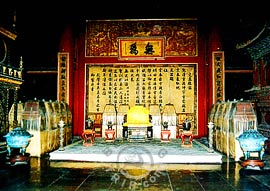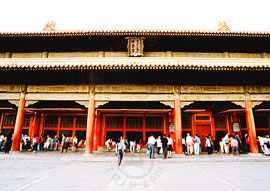 Hall of Union and Peace
Hall of Union and Peace
Located between the Hall of Heavenly Purity and the Hall of Earthly Tranquility, the Hall of Union and Peace (Jiaotai Dian) implies that the union of the heaven and the earth bring peace forth. It was constructed in 1402 and rebuilt in 1789. The hall is similar with the Hall of Central Harmony in its shape, but is comparatively small.

The empress held ceremonies here on the Spring Festival, the Winter Solstice and her birthday, receiving tributes from the imperial concubines, the princesses and the princes' wives. Since the reign of Emperor Qianlong (the fourth emperor of the Qing Dynasty), the hall was used to keep twenty-five imperial seals, each of which was designed for a certain purpose. These seals are laid in boxes which were covered with damask silk as what they were.
Behind a throne, visitors will see a screen with an article on it. This is an ode to the Hall of Union and Peace written by Emperor Qianlong. Above the screen, there are two characters on a plaque, which advise Emperors to govern the state by virtue. A clepsydra made in 1745 stands in the east of the hall. This device measures time by marking the escape of water, an ancient way used by the Chinese people. In the west, there is a chime clock which looks like a mini-pavilion. It was made early in 1789, but still can tinkle out the exact time today.
 Hall of Earthly Tranquility
Hall of Earthly Tranquility
The Hall of Earthly Tranquility (Kunning Gong) was built in 1420 and was the empress' residence in the Ming Dynasty (1368-1644). In 1655 during the Qing Dynasty (1644-1911), the hall was restored and divided into two parts. The two chambers in the east were changed into bridal rooms for the emperor and empress; while the remaining four chambers were used as a place of worship.

With red-painted walls, beautiful lanterns and many Chinese characters of 'Xi (joy)', the bridal room shows a ubiquitous gaiety. Both the bed-curtain and the quilt are embroidered with a design of one hundred vivacious children with different expressions, conveying a wish that the newlyweds will have many children. The emperor and empress spent several nights in the chambers after their wedding.
The chambers for worship in the west are different from the other halls in their layout. In the Qing Dynasty, daily sacrificial rituals, including a morning rite and an evening rite were conducted at the halls. On hecatomb days, the first day and the fifteenth day of every month, the emperor and empress attended the rituals in person.
 Go to the Next Attractions: Nine Dragon Wall & Imperial Garden
Go to the Next Attractions: Nine Dragon Wall & Imperial Garden